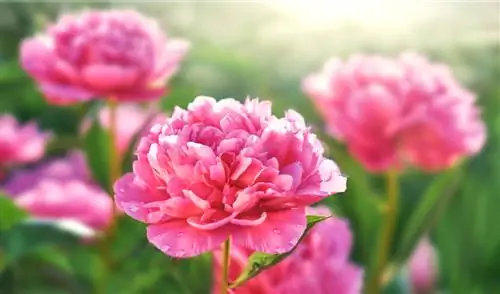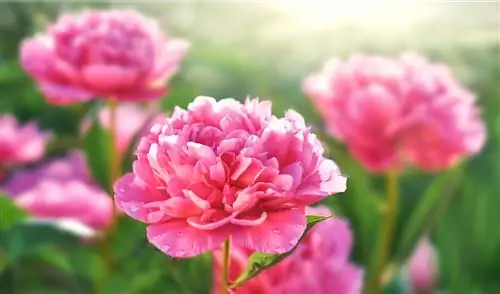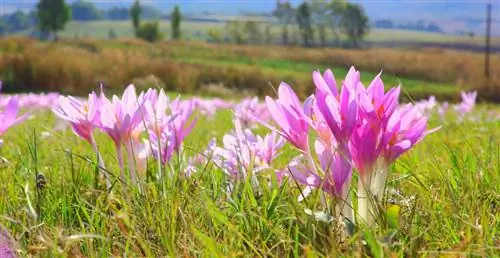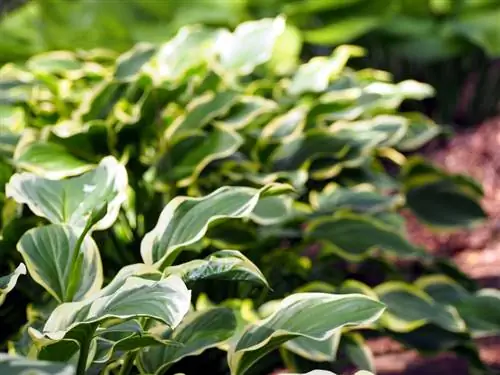- Author admin [email protected].
- Public 2023-12-16 16:46.
- Last modified 2025-06-01 06:02.
In June they bloom magnificently everywhere: red, white, yellow or pink peonies. That's why we'd like to dedicate our plant portrait this month to the thornless flower princess. In Europe, Asia and North America more than thirty species thrive in gardens and parks. The large, fragrant flower balls not only decorate every herbaceous bed, peonies also keep very well in a vase.

What is special about peonies and how do you care for them?
Peonies are magnificent perennials native to Europe, Asia and North America. They prefer sunny locations and humus-rich, well-drained soil. Their main flowering period is in May and June, where they shine in the colors red, white, pink and yellow.
Plant profile:
- Botanical name: Paeonia lactiflora and Paeonia officinalis
- German names: Benedict's rose, farmer's rose, Freisamrose, gout rose, pound rose, horse rose
- Class: Angiosperm
- Genus: Peonies
- Family: Peonies
- Growth height: Up to one meter
- Main flowering period: May - June
- Leaf color: Dark green
- Leaf shape: compound pinnate, notched leaf edge
- Flower color: red, white, pink, yellow
- Flower shape: Double, semi-double or unfilled calyx
- Fruits: follicle fruit with rounded seeds
Origin
Interestingly, the peony only thrives in the northern hemisphere. It occurs wild in China, Japan and India, where it grows in sparse forests. The perennial species, on the other hand, originally come from Eurasia and North America.
Plant symbolism
In the early Middle Ages, Benedictine monks dedicated themselves to cultivating this wonderful plant. Christian mythology praises the peony as a symbol of healing and the beauty of the feminine. You can find it as an ornament on many altarpieces, because as a “rose without thorns” it is a symbol of the Mother of God.
The botanical genus name “Paeonia” can be traced back to the Greek doctor of the gods “Paian”. According to legend, he used the peony to heal Pluton, the god of the underworld, after he was wounded by Heracles in the war for Pylos.
Planting and care
Peonies love a sunny location where they find humus-rich, nutrient-rich and well-drained soil. You can also give shrub peonies a partially shaded spot as long as they are exposed to direct sunlight for a few hours a day.
Prevent waterlogging with a drainage layer, as the thornless flower princess reacts quickly to this with root rot. Temporary drought is better tolerated because the peony forms roots that reach deep into the earth and can store water in the root system.
It is best to plant peonies in early autumn and give them enough space. Depending on the species and variety, the planting distance should be 1 to 1.5 meters. In the first few years the perennials still need good winter protection, later they are very robust and frost hardy.
He althy growth is promoted by fertilizing with compost soil or composted manure. Horn shavings or horn meal are also suitable. Two fertilizer applications per year, once in spring and once in summer, directly after flowering, are sufficient.
Diseases and pests
Peonies are among the perennials that are rarely affected by pests and diseases. Neither lice nor caterpillars like to feast on them and snails rarely attack them either.
However, various fungal diseases can cause problems for garden beauties. If the shoots show round, reddish-brown spots or begin to wilt for no apparent reason, rapid action is required. Cut off affected plant parts and dispose of them in household waste. You can then treat the peony with a commercial fungicide.
Tip
Never plant peonies too deep because then they won't bloom. The thick shoot buds must be close to the ground. Don't lose patience, because the “rose without thorns” needs some time to get started. Peonies often only begin to bloom after two to three years, but then become more lush from year to year. That's why this garden beauty should have a place where it can remain undisturbed for a long time.






